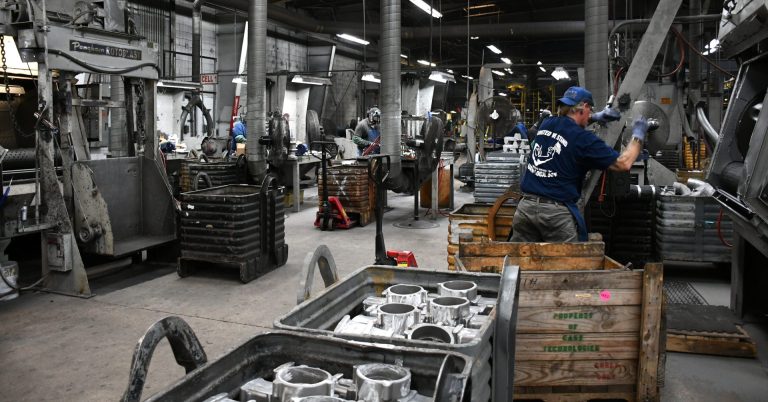Grasping Aluminum Casting: Proven Methods to Enhance Manufacturing Effectiveness
Wiki Article
Study the Globe of Aluminum Spreading: Recognizing the Various Approaches
Aluminum spreading is a fundamental process in the manufacturing market, with numerous approaches used to produce specific and detailed elements. Comprehending the different methods utilized in light weight aluminum spreading can offer useful understandings right into the capacities and constraints of each method. From the traditional sand casting technique to the sophisticated die spreading procedure, each technique supplies distinct advantages depending upon the requirements of the job. Exploring these varied techniques can supply a thorough sight of the possibilities within the globe of aluminum casting and just how each technique adds to shaping the contemporary manufacturing landscape.Sand Spreading Technique
Sand casting, a widely-used method in aluminum spreading procedures, involves producing molds made of compacted sand for pouring molten steel. As soon as the mold and mildew is prepared, it is safely placed in a flask and molten aluminum is put right into the tooth cavity.After the metal has cooled down and strengthened, the sand mold is broken away to disclose the light weight aluminum casting. Sand casting permits the production of complicated shapes and huge components that may be expensive or hard to create utilizing other approaches. It is also a sustainable strategy as the sand can be recycled and used numerous times, minimizing waste in the spreading process.
Permanent Mold Technique

One significant benefit of the Irreversible Mold And Mildew Strategy is the boosted dimensional precision it supplies. The metal mold enables for tighter tolerances and finer details in the last aluminum spreadings contrasted to sand casting methods. This precision makes it a preferred choice for applications where tight dimensional control is vital, such as in the auto and aerospace sectors.

Die Casting Refine

Investment Casting Method
Using a precision spreading technique, Investment Casting Approach entails producing elaborate aluminum parts by pouring liquified steel into a ceramic mold and mildew. This procedure, also recognized as lost-wax casting, starts with the development of a wax pattern of the desired part (aluminum casting).Financial investment spreading is commonly made use of for manufacturing elements in sectors where intricate styles and limited resistances are called for, such as aerospace, automotive, and clinical equipment. The versatility and accuracy of the Investment Casting Approach make it a beneficial technique in the world of aluminum casting.
Lost Foam Casting Technique
Having discovered the elaborate precision of Investment Casting Method, the focus now changes to the innovative method of Lost Foam Casting in aluminum component manufacturing. Lost Foam Casting, likewise referred to as evaporative pattern spreading, is a contemporary strategy where a foam continue reading this pattern of the wanted component is created and after that coated with a refractory material. The covered foam pattern is then buried in sand, and molten light weight aluminum is put right into the mold and mildew. As the steel fills up the mold and mildew, the foam vaporizes as a result of the heat, leaving a tidy tooth cavity in the shape of the wanted component.Among the major benefits of Lost Foam Casting is its ability to generate complicated shapes with intricate details, frequently in a single piece without the demand for extra machining. This method is additionally recognized for its high dimensional accuracy and smooth surface area coating. Furthermore, Lost Foam Spreading is a cost-effective procedure as it decreases the need for cores and permits check here the production of light-weight elements. Despite its benefits, Lost Foam Casting calls for careful control of the spreading process to make certain and stop defects top quality components.
Final Thought
Finally, aluminum casting supplies a variety of techniques such as sand spreading, permanent mold technique, pass away spreading, investment casting, and shed foam spreading. Each approach has its very own advantages and applications, making aluminum casting a flexible and extensively made use of process in different markets. Recognizing the differences in between these approaches is essential in choosing one of the most ideal spreading technique for particular production demands.Sand spreading, a widely-used method in aluminum casting processes, includes producing molds made of compacted sand for putting molten metal. aluminum casting.The Irreversible Mold Method, like sand spreading, is one more widespread approach utilized in light weight aluminum spreading procedures, using unique benefits in terms of mold reusability and dimensional precision. The metal mold and mildew permits for tighter resistances and better information in the final aluminum castings contrasted to sand spreading techniques. The two primary types of die casting are cold chamber pass away spreading and warm chamber pass away casting, each suitable for different types of aluminum alloys.In conclusion, light weight aluminum spreading uses a range of techniques such as sand casting, permanent mold and mildew strategy, die spreading, financial investment spreading, and shed foam spreading
Report this wiki page